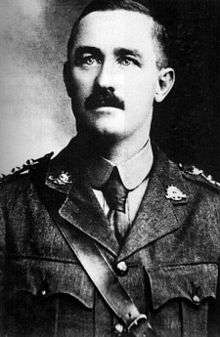Frederick Tubb
| Frederick Harold Tubb | |
|---|---|
 Captain Frederick Tubb c.1916 | |
| Born |
28 November 1881 Longwood, Australia |
| Died |
20 September 1917 (aged 35) Passchendaele, Belgium |
| Buried | Lijssenthoek Military Cemetery |
| Allegiance | Australia |
| Service/ | Australian Army |
| Years of service | 1900–17 |
| Rank | Major |
| Unit | 7th Battalion |
| Battles/wars | |
| Awards | Victoria Cross |
Major Frederick Harold Tubb, VC (28 November 1881 – 20 September 1917) was an Australian recipient of the Victoria Cross, the highest award for gallantry in the face of the enemy that can be awarded to British and Commonwealth forces.
Life and military
Tubb was born on 28 November 1881 to Harry and Emma E. Tubb, of St. Helena, Longwood East, Victoria, Australia.[1]
He was 33 years old, and a lieutenant in the 7th Battalion, Australian Imperial Force, during the First World War when he was awarded the VC for his actions on 9 August 1915 at Lone Pine, Gallipoli. Lieutenant Tubb held a newly captured trench which was being counter-attacked by the enemy, who blew in a sand-bag barricade, leaving only a foot of it standing. Tubb led his men back, repulsed the enemy and rebuilt the barricade. Twice more the enemy blew in the barricade, but on each occasion this officer, although wounded in the head and arm, held his ground and assisted by corporals Alexander Burton and William Dunstan, rebuilt it, and maintained the position under heavy bombardment.
Citation
For most conspicuous bravery and devotion to duty at Lone Pine trenches, in the Gallipoli Peninsula, on 9th August, 1915. In the early morning the enemy made a determined counter attack on the centre of the newly captured trench held by Lieutenant Tubb. They advanced up a sap and blew in a sandbag barricade, leaving only one foot of it standing, but Lieutenant Tubb led his men back, repulsed the enemy, and rebuilt the barricade. Supported by strong bombing parties, the enemy succeeded in twice again blowing in the barricade, but on each occasion Lieutenant Tubb, although wounded in the head and arm, held his ground with the greatest coolness and rebuilt it, and finally succeeded in maintaining his position under very heavy bomb fire.
He later achieved the rank of major and died of wounds suffered in battle at Polygon Wood, in the Third Battle of Ypres, on 20 September 1917. In this action Major Tubb was serving with 7th Battalion, 2nd Brigade, 1st Australian Division when he was shot by a German sniper. While being carried to the rear he was struck by British artillery shells. He died at the dressing station at Lijssenthoek and was buried at Lijssenthoek Military Cemetery, Belgium.[1]
Medals
His Victoria Cross is displayed at the Australian War Memorial in Canberra, along with the eight other Australian Gallipoli VCs.
Tubb was awarded:
References
- 1 2 Tubb, Frederick Harold, Commonwealth War Graves Commission
- ↑ "No. 29328". The London Gazette. 15 October 1915. p. 10154.
- ↑ RELAWM15368.001 – Victoria Cross : Captain F H Tubb, 7 Battalion AIF, Australian War Memorial
- ↑ RELAWM15368.002 – 1914–15 Star : Captain F H Tubb, 7 Battalion AIF, Australian War Memorial
- ↑ RELAWM15368.003 – British War Medal 1914–20 : Major F H Tubb, 7 Battalion AIF, Australian War Memorial
- ↑ RELAWM15368.004 – Victory Medal : Major F H Tubb, 7 Battalion AIF, Australian War Memorial
External links
- H. Murray Hamilton, 'Tubb, Frederick Harold (1881–1917)', Australian Dictionary of Biography, Volume 12, Melbourne University Press, 1990, pp 273–274.
- Lieutenant Frederick Tubb VC, People profiles, Australian War Memorial
- timeline; Cigarette card; Photographs: P02939.004; A02633; A02287; C02014